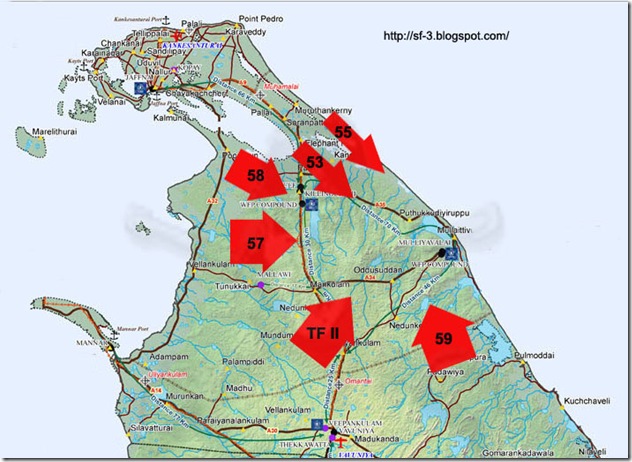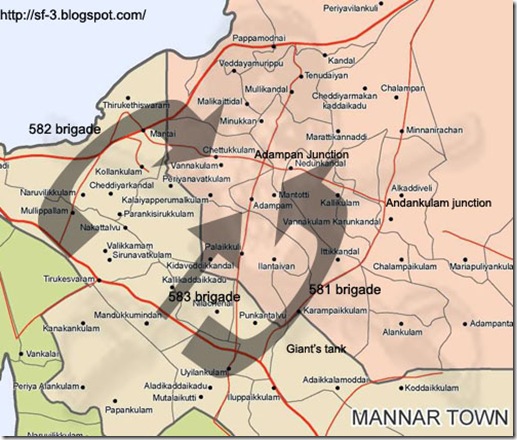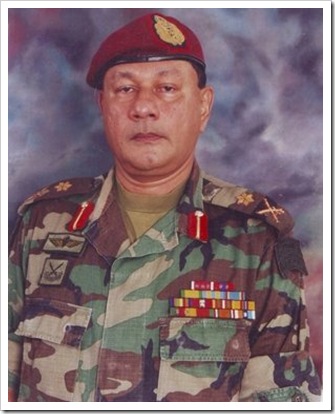Tamil Tigers' worst nightmare: A Counterstrike, too little too late
Defensive battle is always a gamble. Defending commanders have deliberately chosen to absorb an enemy assault they know is coming, inviting the enemy to attack where it might most effectively be destroyed. If the strategy works the weakened attacker is left with little force to resist a counterstrike, if it fails the defenders will be left with no alternative but surrender.
There are many facets of defensive battle. One is to entice an enemy towards you to maintain the initiative to give the enemy an idea of vulnerability but to draw them into a situation from which they cannot return and then to launch a spectacular counterstrike. Another is to worn the enemy off by building strong defensive positions that fighting against them would cause the enemy huge casualties and huge distress. In order to opt which of these is the ideal, the commander must have good and accurate intelligence on the enemy's intentions. It is vital to know what the enemy's intentions are, what their strengths are what their weaknesses are because a commander with such detailed intelligence can prepare not only to exploit the enemy's weaknesses but also prepare to strengthen his own weaknesses. With these intelligence at hand the commanders must have sufficient time to finalise their defensive battleplan and to prepare the ground on which the battle will be fought. At the start of the campaign the defending troops and the defensive positions must be able to stand up against and absorb the enemy attack especially when its at its ferocious and deter the enemy long enough and grind them till the commanders decide an opportune moment to launch their counterattack. Commanders must be realistic of their objectives of the counterstrike and not overstretch themselves. Such a counterstrike at any stages remains the crucial factor in the defensive battle, battleplan. It is almost always the last act.
However, this plan has two great dangers. First being, this requires significant and sometimes deliberate sacrifice of one's own soldiers. Therefore maintaining morale dictates that defending troops must not know they are part of a deliberately planned defensive battle. And the population might think of the defensive battle as a negative set back and not understand that it can be a part of a war winning plan. Secondly a defensive battle commander is inviting the enemy to attack him but he may never really know the enemy's full intentions. It very well might be the enemy who actually has the initiative intending to pin the defensive forces down and outflank them from elsewhere.
During the first World War, obliged to fight a war on two fronts- against Russia in the East and France in the West- the central powers, Germany and Austro-Hungary desperately required to preserve their dwindling manpower, for the horrific slaughters at Verdun and at the Somme in 1916 had exhausted the Germans as much as the French and the British. To shorten their defence line and thus economise on troops, the Central powers decided to build formidable fortifications across the vulnerable open country side of the Western and Central sectors of the Western front during the winter of 1916. This was named the Hindenberg Line. With this line German Field Marshall von Hindenberg was playing a longer game, preparing the central powers to absorb multiple British or French attacks until conditions changed and a counterstrike can be mounted. The Germans however also calculated that another campaigning season might see Russia collapse in the East. If that happens massive new forces will be released for a showdown in the West. To achieve this delay and free the forces pinned down in the East were the main objective of the Hindenberg line that ran for 90 miles from the north sea to Verdun. The Germans believed it was impregnable. Hindenberg hoped that this line was so formidable that it may persuade the allies not to attack buying him the time he needed.
If the Lucy ring operating off Switzerland which was part of the Soviet Red Orchestra spy network of disaffected German officers were passing on German plans of the Battle of Kursk, in 1917 Hindenberg did not have this level of intelligence on British intentions. He only knew that an allied offensive will come. Nevertheless Hindenberg's line held up well against a variety of allied assaults such as the April 1917 Arras offensive where wave after wave of allied assaults were conducted on fruitless attempts of a breakthrough. The French army suffered serious casualties and collapsed putting it out of action for the rest of the year as a result. Throughout 1917, Hindenberg's defensive battleplan had achieved its objective with the British still struggling at the Passchendaele ridge only 6 miles from where they started. This bought the Germans vital time. In the end, the wait paid off. At the East the Russian revolution was sweeping across Russia. By March 1917 the Czar abdicated and during July 1917 a final desperate Russian offensive was comprehensively beaten by the Germans.
In defensive battle the defending commander has an inherent advantage as far as intelligence is concerned. In particular he has the opportunity to gain intimate knowledge of the terrain over which the battle will be fought. Hindenberg's line was prepared over a year earlier. The section code named Siegfried in front of the town Cambrai where Haig had decided to launch his attack was 5.5 miles deep with excellent use of terrain. The defences incorporated thick belts of barbed wire, machine gun posts and trenches designed to stop tanks. Further behind these, to conserve troops Hindenberg established mobile reserves to reinforce whatever point the allies breached.
The key operational problem of most defending forces is to gather enough time to muster sufficient reserves to nullify the differential concentration. In military parlance this means that attackers usually employ a disproportionately high concentration of force employment against a small portion of the defender's lines by using the initiative and surprise. Traditionally in the 1915s an attack was preceded by days of bombardment. This warns defenders that an offensive is shaping up in the horizon, advertising the point of attack and provided the defender vital time required to shift its reserves from elsewhere and even the numerical superiority or the differential concentration. But at Cambrai the early morning of November 20th 1917 was silent. The Germans with prior experience of day long bombardments were not expecting an attack. At 0620 hours the British employed the modern tactic the Hurricane Barrage which included a 1000 gun barrage and the bombardment by 14 squadrons of the Royal Flying Core. 300 tanks leading 6 infantry divisions broke off their lines under the cover of this Hurricane barrage. This new infantry tactics surprised the Germans since they did not anticipate an assault for two reasons. First the approaching winter usually signaled an end to the campaigning season until the spring next year and Hindenberg did not expect Haig to attack his lines yet again in the same year. Second, due to the modern system tactics employed by the British - the Hurricane Barrage - enabled the attackers to begin the assault before the defenders could respond to the local differential concentration.
The British tanks tore through the seemingly impregnable defences. By 0800 hours the British had overrun the main Hindenberg line and by mid afternoon the British had advanced astonishingly over 6Kms. Such an advance was not accomplished in 4 months of fighting during the third battle of Ypres. At first it seemed the German defences were collapsing. However, Hindenberg's defensive battleplan made the British to be held up at the middle of the front with German field guns and machine gun posts that lay out of the range of the initial Hurricane Barrage. Hindenberg's defensive depth also meant that the British had to travel an increased distance through this 'Devil's Garden' to breakthrough completely. Once an attacker begins to break through such depth, its power progressively erodes. This entropic effect of depth, thus sets up the defender's reserves ability for a successful counterattack. In this process the British lost 179 tanks with 4000 casualties in just the first day. After 10 days since the beginning of the offensive the British were exhausted. Their lines of communication were stretched and they were still within the network of German defences. During this time the German defenders were slowing down the British advance enough to bring in the reserves for the next stage of Hindenberg's battleplan - the Counterstrike. They soaked up and entangled the British advance sufficiently enough for the counterattack phase.
Hindenberg's counterstrike concentrated on the Southern end of the British line where the British were at their weakest. Hindenberg launched an hour long barrage, while small infantry teams infiltrated through the British defences softened up by the hour long barrage and took out the British guns that were thought to be safe in the rear. These specialist counterattack infantry teams used innovative tactics such as machine pistols and flame throwers to neutralise the fire support bases. This German counterattack managed to push back the British some 8 miles into the Southern British sector well beyond the original British line before the November 20th offensive. However Hindenberg ordered his men to take the counterstrike far enough to return the frontline to its approximate positions before the British offensive.
Like Hindenberg commanders must be realistic about their objectives and not overstretch themselves. One of the most important aspects of the counterstrike plan will be how far that counterstrike should push before coming to its culminating point. The last thing a commander launching a counterstrike would want is to find himself at the end of a tenuous line of communication and vulnerable to a counterstrike himself.
Since the fall of the Eastern province, the Tamil Tigers have been conducting defensive battle on 4 main fronts. This defensive battle was either forced by the multi-axis fronts opened by the Sri Lankan armed forces, or planned deliberately by the Tamil Tiger battleplanners attempting to emulate what they did during the 1997 Jayasikurui campaign where they vacated large swathes of land. What is surprising in these series of limited operation conducted by the armed forces is the fact that, large scale counter attacks that reversed the campaign outcomes in a matter of days has not featured in the Tamil Tiger battle plan of Eelam war IV yet. With territory fast shrinking and vital supply bases and coastal belts falling into Government hands, how long the Tamil Tigers plan to conduct their defensive battleplan remains to be seen. Defensive battle is always a gamble and for the Tamil Tigers any miscalculation thereby a failure is quite catastrophic.
If the Tamil Tigers are indeed emulating the Hindenberg tactics, it surely is bound to fail for a number of reasons. If Hindenberg had a clear objective - to buy time by deterring the enemy for as long as his Eastern Russian threat was negated - with the current ground realities it is questionable as to whether the Tamil Tigers do have an overall objective. Like Hindenberg if the Tamil Tigers are buying time, it would either be hoping to seek international intervention or for the heavens to open up with the hope of driving the invading SLA to a muddy quagmire it faced during the last stages of Jayasikurui and during the early stages of the Wanni offensive last year to a lesser extent.
The heavily fortified NACHCHIKUDA-AKKARAYANKULAM earth bund is a good deterrent for any invading force. However it is geometrically permanent and allows to be easily surveyed from air and LRS teams thus allowing the SLA to build plans around it. It also fails to deliver defensive depth (unlike the Hindenberg line) to its key towns and areas of strategic importance such as POONERYN and KILINOCHCHI, hence a few punched holes in its defence presents the SLA's elite reserves to pour in towards the area behind this earth bund which is relatively undefended and wreak havoc among the Tamil Tiger supply chains. This renders the Tamil Tiger FDLs incapable of functioning at full efficiency. These are the objectives of the SLA attack teams - breakthrough and exploitation - gaining access to the rear which holds the guerilla supporting infrastructure. If Hindenberg's defenders managed to cause severe casualties and immense distress on the attacking British and the French, thus far the Tamil Tigers have not managed to inflict such levels of casualties on the marauding small strike teams of SLA divisions. (The tactics of such small unit independent manoeuvre will be briefed more in detail in a future brief of mine).
Yet another reason as to why the Tamil Tiger defensive battle gamble is poised to fail is its severe lack of intelligence. During the early days of the battles for ADAMPAN (ATTAMPANA) the Tamil Tigers had fortified the UYILANKULAM-ADAMPAN road expecting 58 Division to meet the defenders head on. Instead, meeting head on turned out to be a SLA tactic that pinned down the Tamil Tiger defenders with fixing attacks while the 581 and 582 had encircled the town with a double envelopment. As mentioned above without vital intelligence defensive battle is a risky gamble. It very well might be the enemy who actually has the initiative intending to pin the defensive forces down and outflank them from elsewhere.
The inherent risks of Defensive battle: It very well might be the enemy who actually has the initiative with the intention to pin the defensive forces down and outflank them from elsewhere.
If the Tamil Tigers are to launch a Oyatha Alaikal (Ceaseless Waves) type assault bringing its lost territory and pushing the FDLs to status quo ante, it surely is risking overstretching itself in the process and hence being very vulnerable to a potential counterstrike by the SLA themselves, for in the current theatre of operations the Sri Lankan battleplanners have made sure they have left no vulnerable salient for the Tamil Tigers to exploit as happened before. With a dwindling experienced cadre base and supplies, how long it can hold and continue such a counterstrike, if it opts to, remains to be seen. As mentioned above once an attacker begins to break through such depth, its power progressively erodes. This entropic effect of depth, thus sets up the SLA's reserves ability for a successful counterattack.
Perhaps this is another reason - not to overstretch itself during its counterattack - why the only form of counterattack the Tamil Tigers have thrown against the 57, 58 and 59 Divisions thus far has been limited attempts at re-capturing vital strong points or grounds of tactical importance. The majority of current limited counterstrikes have taken place along the Earth bund spanning across from NACHCHIKUDA to AKKARAYAN where Sri Lankan armed forces have pierced more than 3 points and have stationed themselves on this earth bund. In some positions the warring parties are positioned as close as a few yards.
As mentioned in an earlier brief there are many reasons why thus far the Tamil Tigers have not opted the final phase of a defensive battleplan - the countertsrike. Main among them has been SLA's superior intelligence apparatus, superior defensive tactics (which I will brief in the future), superior aerial surveillance platforms hovering above monitoring FDLs on a 24/7 basis and the Tamil Tigers' lack of leadership and SLA's pursuit of eliminating key Tamil Tiger field operatives. Not all commanders have the ability to launch a counterattack battleplan. As much as a commander that leads an offensive into enemy territory needs to be dynamic and bold, the commander who launches the counter strike needs to be even more dynamic and even more bolder often because he himself has just suffered a defeat and he’s just got to take on an enemy that’s just won a victory and exploit a certain success that might not be eagerly apparent to him. What he needs to do is to move quickly, he needs to be fast and above all, he needs to throw caution to the wind. With the Tamil Tigers losing its premier commanders with the likes of renegade Karuna, Balraj, Charles, Thamil Chelvan etc it is unlikely that the replacements will be able to emulate and deliver the same dynamic bold feats and charisma of these late commanders.
With a decisive counterstrike capable of returning the FDLs to status quo ante yet to materialise, the Sri Lankan armed forces, adhering to its own deadlines and tactics will continue to inch in further into Tamil Tiger territory, making it even harder for the Tamil Tigers to stage a comeback with supplies and cadre strength diminishing each day due to daily attrition. As each day passes by, as troops inch closer and closer towards KILINOCHCHI and POONERYN, the day the premier battle hardened offensive divisions 53 and 55 will unleash itself is not far off. Any counterstrikes afterwards may come too little too late for the Tamil Tigers.
Only time will tell...







